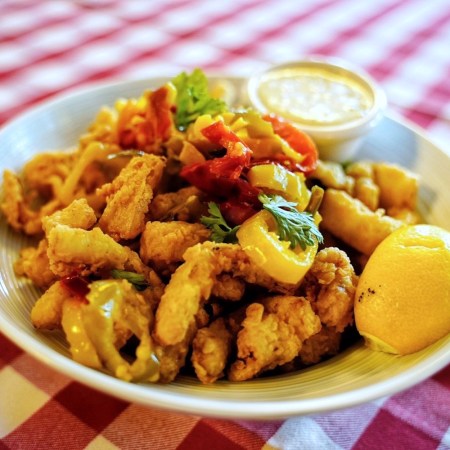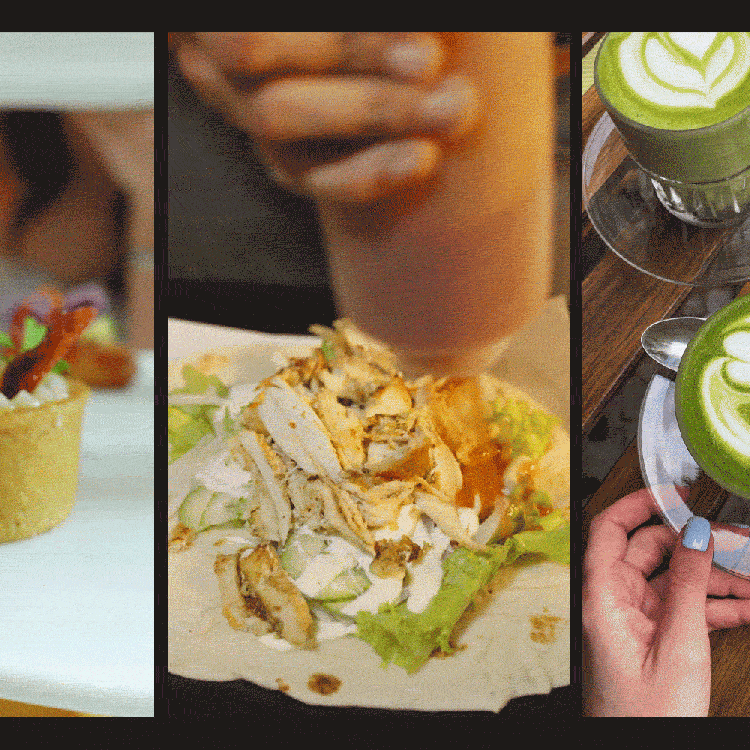Growing up in Cleveland, Kenny Gilbert always ate spaghetti with his fried chicken. “Whenever my mom would have fried chicken ready to go, she’d usually make a pot of green beans cooked with a little bit of bacon, apple cider vinegar, brown sugar and a pinch of crushed pepper flakes,” Gilbert says. “And then it was always a nice big old pot of spaghetti with meat sauce.”
It’s always interesting to see how different regions of the United States interpret the same dish. Whether spaghetti and fried chicken readily coexist on dinner tables across Northeast Ohio or it’s just a thing in Gilbert’s home, the melting pot of cultural and regional influences is what makes eating in this country so great. Add international travel to the mix, and the possibilities of how to embellish your favorite dish are endless. It’s exactly what Chef Gilbert explores in his debut cookbook Southern Cooking, Global Flavors, which reimagines iconic dishes of the American South with his experience cooking around the world.
Some of us are super adventurous eaters — we want to try anything and everything, and probably like all of it, too. Others are more cautious and find comfort in familiar flavors and preparations. Luckily, Gilbert’s book works both ways. For example, if you’re always looking to expand your palate, you’ll likely be drawn to the Turkey Meatloaf with Moroccan Spices and Cashew-Cauliflower in the “Meatloaf & Mashed Potatoes” chapter. But if you want to stick to the spices you have in your cabinet, there’s probably a recipe for you, too.

“During COVID, I did a Zoom cooking class for a family in London, and the wife was Indian and the husband was British,” Gilbert says. “And the wife said, ‘I’m so excited about wanting to make classic fried chicken and biscuits, but we weren’t able to get some of the seasonings like lemon pepper and Lawry’s Seasoned Salt.’ And so I said, ‘Do you have madras curry powder, cumin, coriander or garam masala?’ They did, so I showed them how to make the fried chicken, and it was seasoned with what they had in their home. That’s what I thought about with the cookbook. I can teach the technique of making fried chicken, then they can season it however they want. And that was the epiphany moment.”
While an Indian-inspired version doesn’t show up in the book’s “Fried Chicken & Biscuits” chapter, you will find a Korean variation, as well as Kung Pao fried chicken sandwiched in a peanut butter biscuit. There are sections for “Oxtails & Rice” and “Fish & Grits,” among others, but a personal favorite is the “Seafood Boils” chapter.
Here’s Everything You Need to Make Sweet and Sour Pork Ribs at Home
Umamicart co-founder Andrea Xu shares a recipe for the version of the Chinese classic she grew up eating“I love the classic version that I make because it’s Cajun and buttery and delicious — it’s craveable,” Gilbert says. “But every culture has some kind of boil — Italian cioppino is the same idea. You have Maryland, known for crabs steamed with beer and Old Bay with a little bit of butter and a squeeze of lemon. When you’re dipping and eating, it’s a moment and an experience.”
Gilbert does include a recipe for an Italian-Inspired Seafood Boil, as well as a French Seafood Boil with a Pernod-fennel broth and escargot. A boil is one of those dishes that brings people together over food and conversation — it’s difficult not to connect with your dining companions when you’re wearing a plastic bib and there’s butter dripping down your wrists.
If eating good food together is the great connector, cooking with or for others can build an even stronger bond. Gilbert has worked for the Ritz-Carlton, staged at renowned kitchens in Japan, France, Spain and the Caribbean, and competed on Top Chef. He’s even worked as Oprah’s personal chef, an experience that was rewarding in a multitude of ways. “When you touch someone with food, it’s not like working,” Gilbert says. “You are working, and it’s a lot of work because it’s a lot of people, but she [Oprah] makes sure the experience is 100% like family. She’ll get up from eating that chicken and biscuit and go around and tell everyone they have to get one of these chicken and biscuit sandwiches. When we cook for the family, she makes sure everyone eats. It’s a very warm and loving environment, and it’s like cooking for your cool auntie who loves food and travels and who’s smart and funny. She’s just amazing.”
While we all can’t have Chef Gilbert cooking one of his amazing meals for us, Southern Cooking, Global Flavors brings some of his best recipes to your kitchen. To get you started, his Miso Honey-Glazed Salmon with Bamboo Rice is a light, weeknight-friendly dish you’ll come back to time and again.

Miso Honey–Glazed Scottish Salmon with Bamboo Rice Grits
Servings: 6
Ingredients
- 1 cup honey
- 1 cup gochujang paste
- 1 cup honey
- 1 cup white miso paste
- .25 cup sake
- .25 cup low-sodium soy sauce
- 2 egg yolks
- 6 (5-ounce) skinless Scottish salmon fillets, or other fresh salmon
- .25 cup sesame oil
- 2 cups water
- 1 cup canned coconut milk, preferably Thai Kitchen
- 4 Tbsp. salted butter
- 2 Tbsp. ground ginger
- 1 Tbsp. kosher salt
- .75 cup bamboo rice, soaked overnight
- 1 tsp. freshly ground white pepper
- .25 cup sesame oil
- 6 baby bok choy, halved
- 1 cup water
- .5 cup rice vinegar
- 1 Tbsp. kosher salt
- .5 cup gochujang honey (recipe below)
- .25 cup Chinese douchi (fermented black beans)
- 2 Tbsp. benne or sesame seeds
Directions
-
For the gochujang honey
-
Whisk 1 cup of honey and gochujang paste in a small mixing bowl until well incorporated. Cover and reserve. (The sauce can be made in advance. Stored in an airtight container in the refrigerator, it will be keep for 6 months. Any leftovers can be used as a dipping sauce for fried vegetables, seafood, poultry and pork.)
-
-
For the salmon marinade
-
Whisk 1 cup of honey, miso, sake, soy sauce and egg yolks in a large bowl. Add the salmon fillets and coat in the marinade.
-
Place the salmon and marinade in an airtight container and marinate for 6 to 12 hours in the refrigerator.
-
-
For the bamboo rice
-
Simmer 2 cups of water, coconut milk, butter, ginger and salt in a medium saucepan over medium-high heat.
-
Drain the presoaked rice and add it to the simmering cream mixture, stirring constantly until well mixed.
-
Reduce the heat to low and cook, uncovered, for 20 to 25 minutes, stirring occasionally, until the rice is creamy. Once the rice is fully cooked, add the white pepper. Cover to keep warm.
-
-
For the bok choy
-
Heat a large skillet on medium heat, then pour in .25 cup sesame oil.
-
Sear the baby bok choy in the skillet, cut side down, for 3 minutes. Flip the bok choy and cook for another 3 minutes.
-
Whisk the water and rice vinegar in a small bowl. Add this mixture to the skillet and deglaze the pan, scraping any brown bits from the bottom. Cook for 30 seconds.
-
Turn off the heat and cover with a lid. Let the bok choy steam for 1 minute.
-
Transfer the bok choy and any liquid to a plate. Season with salt and cover with foil to keep warm.
-
-
For the salmon
-
Preheat the broiler. Line a sheet pan with foil and coat with 2 Tbsp. sesame oil.
-
Put the salmon on the oiled pan, top side down.
-
Place the pan on the middle rack of the oven and broil for 8 minutes, or until the tops are browned and caramelized. Drizzle with the remaining 2 Tbsp. sesame oil.
-
-
To finish the dish
-
Place a heaping scoop of bamboo rice in the center of a plate and top with some of the baby bok choy. Place a piece of salmon on top of the bok choy.
-
Drizzle the gochujang honey over the fish, bok choy and rice. Sprinkle with douchi. Finish with a pinch of benne seeds. Plate the remaining servings.
-
Every Thursday, our resident experts see to it that you’re up to date on the latest from the world of drinks. Trend reports, bottle reviews, cocktail recipes and more. Sign up for THE SPILL now.
























